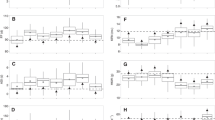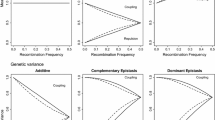Abstract
Key message
Spontaneous haploid genome doubling is not associated with undesirable linkage drag effects. The presence of spontaneous doubling genes allows maximum exploitation of variability from the temperate-adapted BS39 population
Abstract
Tropical non-elite maize (Zea mays L.) germplasm, such as BS39, provides a unique opportunity for broadening the genetic base of U.S. Corn Belt germplasm. In vivo doubled haploid (DH) technology has been used to efficiently exploit non-elite germplasm. It can help to purge deleterious recessive alleles. The objectives of this study were to determine the usefulness of BS39-derived inbred lines using both SSD and DH methods, to determine the impact of spontaneous as compared with artificial haploid genome doubling on genetic variance among BS39-derived DH lines, and to identify SNP markers associated with agronomic traits among BS39 inbreds monitored at testcross level. We developed two sets of inbred lines directly from BS39 by DH and SSD methods, named BS39_DH and BS39_SSD. Additionally, two sets were derived from a cross between BS39 and A427 (SHGD donor) by DH and SSD methods, named BS39 × A427_DH and BS39 × A427_SSD, respectively. Grain yield, moisture, plant height, ear height, stalk lodging, and root lodging were measured to estimate genetic parameters. For genome-wide association analysis, inbred lines were genotyped using genotype-by-sequencing and Diversity Array Technology Sequencing (DArTSeq). Some BS39-derived inbred lines performed better than elite germplasm inbreds and all sets showed significant genetic variance. The presence of spontaneous haploid genome doubling genes did not affect performance of inbred lines. Five SNPs were significant and three of them located within genes related to plant development or abiotic stresses. These results demonstrate the potential of BS39 to add novel alleles to temperate elite germplasm.



Similar content being viewed by others
References
Albrecht V, Simková K, Carrie C, Delannoy E, Giraud E, Whelan J, Small ID, Apel K, Badger MR, Pogson BJ (2010) The cytoskeleton and the peroxisomal-targeted snowy cotyledon3 protein are required for chloroplast development in Arabidopsis. Plant Cell 22:3423–3438. https://doi.org/10.1105/tpc.110.074781
Bernardo R (2020) Breeding for quantitative traits in plants, 3rd edn. Stemma Press, Woodbury, Minnesota
Boerman NA, Frei K, Lübberstedt T (2020) Impact of spontaneous haploid genome doubling in maize breeding. Plants 9:369. https://doi.org/10.3390/plants9030369
Bordes J, Charmet G, De Vaulx RD, Lapierre A, Pollacsek M, Beckert M, Gallais A (2007) Doubled-haploid versus single-seed descent and S1-family variation for testcross performance in a maize population. Euphytica 154:41–51. https://doi.org/10.1007/s10681-006-9266-5
Browning BL, Yu Z (2009) Simultaneous genotype calling and haplotype phasing improves genotype accuracy and reduces false-positive associations for genome-wide association studies. Am J Hum Genet 85:847–861. https://doi.org/10.1016/j.ajhg.2009.11.004
Chang MT, Coe EH (2009) Doubled haploids. In: Larkins BA, Kri AL (eds) Molecular genetic approaches to maize improvement. biotechnology in agriculture and forestry. Springer, New York
De La Fuente GN, Frei UK, Trampe B, Nettleton D, Zhang W, Lübberstedt T (2018) A diallel analysis of a maize donor population response to in vivo maternal haploid induction: I inducibility. Crop Sci 58:1830–1837. https://doi.org/10.2135/cropsci2017.05.0285
Eder J, Chalyk S (2002) In vivo haploid induction in maize. Theor Appl Genet 104:703–708. https://doi.org/10.1007/s00122-001-0773-4
Elshire RJ, Glaubitz JC, Sun Q, Poland JA, Kawamoto K, Buckler ES, Mitchell SE (2011) A Robust, simple genotyping-by-sequencing (GBS) approach for high diversity species. PLoS ONE 6:e19379. https://doi.org/10.1371/journal.pone.0019379
Endelman JB (2011) Ridge regression and other kernels for genomic selection with R package rrBLUP. Plant Genome 4:250–255
Glaubitz JC, Casstevens TM, Lu F, Harriman J, Elshire RJ, Sun Q, Buckler ES (2014) TASSEL-GBS: a high capacity genotyping by sequencing analysis pipeline. PLoS ONE 9:e90346. https://doi.org/10.1371/journal.pone.0090346
Goodman MM (2004) Broadening the U.S. maize germplasm base. Maydica 50:203–214
Hallauer AR, Carena MJ (2014) Adaptation of tropical maize germplasm to temperate environments. Euphytica 196:1–11. https://doi.org/10.1007/s10681-013-1017-9
Hallauer AR, Carena MJ (2016) Registration of BS39 Maize Germplasm. J Plant Regist 10:296. https://doi.org/10.3198/jpr2015.02.0008crg
Hao D, Cheng Y, Chen G, Lu H, Shi M, Zhang Z, Huang X, Mao Y, Xue L (2015) Identification of significant single nucleotide polymorphisms for resistance to maize rough dwarf disease in elite maize (Zea mays L.) inbred lines. Euphytica 203:109–120. https://doi.org/10.1007/s10681-014-1277-z
Jaccoud D, Peng K, Feinstein D, Kilian A (2001) Diversity arrays: a solid state technology for sequence information independent genotyping. Nucleic Acids Res 29:e25. https://doi.org/10.1093/nar/29.4.e25
John JA, Williams ER (1995) Cyclic and computer generated designs. Chapman and Hall, London
Jumbo M, Weldekidan T, Holland JB, Hawk JA (2011) Comparison of conventional, modified single seed descent, and doubled haploid breeding methods for maize inbred line development using germplasm enhancement of maize breeding crosses. Crop Sci 51:1534–1543. https://doi.org/10.2135/cropsci2010.10.0594
Kuznetsova A, Brockhoff PB, Christensen RHB (2017) lmerTest package: tests in linear mixed effects models. J Stat Softw. https://doi.org/10.18637/jss.v082.i13
Lai X, Schnable JC, Liao Z, Xu J, Zhang G, Li C, Hu E, Rong T, Xu Y, Lu Y (2017) Genome-wide characterization of non-reference transposable element insertion polymorphisms reveals genetic diversity in tropical and temperate maize. BMC Genomics 18:702. https://doi.org/10.1186/s12864-017-4103-x
Li T, Yang H, Lu Y, Dong Q, Liu G, Chen F, Zhou Y (2020) Physiological and transcriptomic characterization of a yellow-green leaf mutant of maize. BMC Plant Biol. https://doi.org/10.21203/rs.3.rs-24848/v1
Lipka AE, Tian F, Wang Q, Peiffer J, Li M, Bradburry PJ, Gore MA, Buckler ES, Zhang Z (2012) GAPIT: genome association and prediction integrated tool. Bioinformatics 28:2397–2399. https://doi.org/10.1093/bioinformatics/bts444
Liu X, Huang M, Fan B, Buckler ES, Zhang Z (2016) Iterative usage of fixed and random effect models for powerful and efficient genome-wide association studies. PLoS Genet 12:e1005767. https://doi.org/10.1371/journal.pgen.1005767
Ma H, Li G, Würschum T, Zhang Y, Zheng D, Yang X, Li J, Liu W, Yan J, Chen S (2018) Genome-wide association study of haploid male fertility in Maize (Zea Mays L.). Front Plant Sci 9:974. https://doi.org/10.3389/fpls.2018.00974
Melchinger AE, Schmidt W, Geiger HH (2010) Comparison of testcrosses produced from F2 and first backcross populations in Maize. Crop Sci 28:743–749. https://doi.org/10.2135/cropsci1988.0011183x002800050004x
Melchinger AE, Schopp P, Müller D, Schrag TA, Bauer E, Unterseer S, Homann L, Schipprack W, Schön C (2017) Safeguarding our genetic resources with libraries of Doubled-Haploid lines. Genetics 206:1611–1619. https://doi.org/10.1534/genetics.115.186205
Prigge V, Sánchez C, Dhillon BS, Schipprack W, Araus JL, Bänziger M, Melchinger AE (2011) Doubled haploids in tropical maize: I. effects of inducers and source germplasm on in vivo haploid induction rates. Crop Sci 51:1498–1506. https://doi.org/10.2135/cropsci2010.10.0568
Prigge V, Babu R, Das B, Rodriguez MH, Atlin GN, Melchinger AE (2012) Doubled haploids in tropical maize: II. Quantitative genetic parameters for testcross performance. Euphytica 185:453–463. https://doi.org/10.1007/s10681-012-0626-z
Ren J, Boerman N, Liu R, Wu P, Vanous K, Trampe B, Frei UK, Chen S, Lübberstedt T (2020) Mapping of QTL and identification of candidate genes conferring spontaneous haploid genome doubling in maize (Zea mays L.). Plant Sci 293:110337. https://doi.org/10.1016/j.plantsci.2019.110337
Rio S, Mary-Huard T, Moreau L, Bauland C, Palaffre C, Madur D, Combes V, Charcosset A (2020) Disentangling group specific QTL allele effects from genetic background epistasis using admixed individuals in GWAS: An application to maize flowering. PLoS Genet 16:e1008241. https://doi.org/10.1371/journal.pgen.1008241
Romay MC, Millard MJ, Glaubitz JC, Peiffer JA, Swarts KL, Casstevens TM, Elshire RJ, Acharya CB, Mitchell SE, Flint-Garcia SA, McMullen MD, Holland JB, Buckler ES, Gardner CA (2013) Comprehensive genotyping of the USA national maize inbred seed bank. Genome Biol 14:R55. https://doi.org/10.1186/gb-2013-14-6-r55
Shikha M, Kanika A, Rao AR, Mallikarjuna MG, Gupta HS, Nepolean T (2017) Genomic selection for drought tolerance using genome-wide SNPs in Maize. Front Plant Sci 8:550. https://doi.org/10.3389/fpls.2017.00550
Smelser A, Gardner C, Blanco M, Lübberstedt T, Frei UK (2016) Germplasm enhancement of maize: a look into haploid induction and chromosomal doubling of haploids from temperate-adapted tropical sources. Plant Breed 135:593–597. https://doi.org/10.1111/pbr.12397
Srivastava RK, Singh RB, Pujarula VL, Bollam S, Pusuluri M, Chellapilla TS, Yadav RS, Gupta R (2020) Genome-wide association studies and genomic selection in pearl millet: advances and prospects. Front Genet 10:1389. https://doi.org/10.3389/fgene.2019.01389
Stewart G, Morris MR, Genis AB, Szucs M, Melbourne BA, Tavener SJ, Hufbauer RA (2017) The power of evolutionary rescue is constrained by genetic load. Evol Appl 10:731–741. https://doi.org/10.1111/eva.12489
Strigens A, Schipprack W, Reif JC, Melchinger AE (2013) Unlocking the genetic diversity of maize landraces with doubled haploids opens new avenues for breeding. PLoS ONE 8:7–9. https://doi.org/10.1371/journal.pone.0057234
Tanksley SD, Nelson JC (1996) Advanced backcross QTL analysis: a method for the simultaneous discovery and transfer of valuable QTLs from unadapted germplasm into elite breeding lines. Theor Appl Genet 92:191–203. https://doi.org/10.1007/BF00223376
Trampe B, Santos IG, Frei UK, Ren J, Chen S, Lübberstedt T (2020) QTL mapping of spontaneous haploid genome doubling using genotyping-by-sequencing in maize (Zea mays L.). Theor Appl Genet 133:2131–2140. https://doi.org/10.1007/s00122-020-03585-1
Utz HF, Bohn M, Melchinger AE (2001) Predicting progeny means and variances of winter wheat crosses from phenotypic values of their parents. Crop Sci 41:1470–1478. https://doi.org/10.2135/cropsci2001.4151470x
Verzegnazzi AL, Santos IG, Krause MD, Hufford M, Frei UK, Campbell J, Almeida VC, Zuffo LT, Boerman N, Lübberstedt T (2021) Major locus for spontaneous haploid genome doubling detected by a case-control GWAS in exotic maize germplasm. Theor Appl Genet 134:1423–1434. https://doi.org/10.1007/s00122-021-03780-8
Whitaker D, Williams ER, John JA (2002) CycDesigN: a package for the computer generation of experimental designs. CSIRO Forestry and Forest Products, Canberra.
Wu P, Ren J, Li L, Chen S (2014) Early spontaneous diploidization of maternal maize haploids generated by in vivo haploid induction. Euphytica 200:127–138. https://doi.org/10.1007/s10681-014-1166-5
Ye H, Du H, Tang N, Li X, Xiong L (2009) Identification and expression profiling analysis of TIFY family genes involved in stress and phytohormone responses in rice. Plant Mol Biol 71:291–305. https://doi.org/10.1007/s11103-009-9524-8
Zalapa JE, Staub JE, McCreight JD, Chung SM, Cuevas H (2007) Detection of QTL for yield-related traits using recombinant inbred lines derived from exotic and elite US Western Shipping melon germplasm. Theor Appl Genet 114:1185–1201. https://doi.org/10.1007/s00122-007-0510-8
Acknowledgements
This work was supported by USDA’s National Institute of Food and Agriculture (grant numbers: IOW04714, IOW05520; IOW05510; IOW05656; NIFA award 2018-51181-28419 and 2020-51300-32180), US. Department of Agriculture, Agricultural Research Service, the Iowa State University Plant Sciences Institute, Iowa State University Crop Bioengineering Center, R.F. Baker Center for Plant Breeding, and the K.J. Frey Chair in Agronomy at Iowa State University. Mention of trade names or commercial products in this publication is solely for the purpose of providing specific information and does not imply recommendation or endorsement by the U.S. Department of Agriculture. USDA is an equal opportunity provider and Employer.
Funding
The funding was provided by USDA (Grant no. IOW04714, IOW5520, IOW05656, IOW05510) Institute of Food and Agriculture (Grant no. 2018–51181-28419) National Institute of Food and Agriculture (Grant no. 2020–51300-32180)
Author information
Authors and Affiliations
Contributions
ALV, UKF, TL design the project and performed the experiments. IGS, ALV, JE, NB, LTZ, LPMP, GLF analyzed the data. IGS, ALV wrote the manuscript. All authors read and approved the final manuscript.
Corresponding author
Ethics declarations
Conflicts of interest
The authors declare that they have no conflict of interest.
Key message
Spontaneous haploid genome doubling is not associated with undesirable linkage drag effects. The presence of spontaneous doubling genes allows maximum exploitation of variability from the temperate-adapted BS39 population.
Additional information
Communicated by Alain Charcosset.
Publisher's Note
Springer Nature remains neutral with regard to jurisdictional claims in published maps and institutional affiliations.
Supplementary Information
Below is the link to the electronic supplementary material.
Rights and permissions
About this article
Cite this article
Santos, I.G., Verzegnazzi, A.L., Edwards, J. et al. Usefulness of temperate-adapted maize lines developed by doubled haploid and single-seed descent methods. Theor Appl Genet 135, 1829–1841 (2022). https://doi.org/10.1007/s00122-022-04075-2
Received:
Accepted:
Published:
Issue Date:
DOI: https://doi.org/10.1007/s00122-022-04075-2




